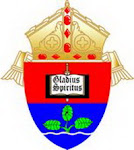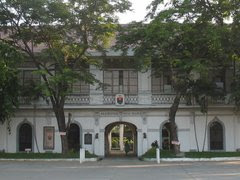The pilgrim Lady:
The itinerary of the Blessed Image of Our Lady of Piat started in Macao (China) from where it was brought to Manila (Philippines). From Manila she was taken to Lallo (north of Luzon) and from there to Piat. From Piat she was taken to Tuguegarao till, finally, she was brought once again, and nor now good, to Piat, as we will describe in the following paragraphs. All the authors mentioned above concur in telling us that the Image of Our Lady venerated in the Ermita or Santuario of Piat had been "made in Macao, colony and city of the Portuguese in the kingdom of the great China, and from thee it was brought to the Philippines)." (Fr. Aduarte). Fr. Malumbres adds that "the image of Our Lady of the Visitation was made by the Chinese in Macao" (15). It should be noticed that the original title of the Image was "Our Lady of the Holy Rosary," while later on the name was changed to that of Our Lady of Visitation." With her liturgical festivity celebrated on July 2. No description of the Image is given by any of the historians., though it is often mentioned that is " of talla" (a sculpture or statue, as opposed to a painting or canvass). We assume, and there is absolutely no reason to doubt it, that the image is the same one venerated at present in Piat, and all of us are very familiar with the way she looks. To my surprise, I have been told by our dear archbishop Diosdado A. Talamayan, that the Image is made of "Paper-mache," The Webster Dictionary defines "paper mache" as a light and strong molding material of high plasticity made typically from water paper pulped with glue and other additives," According to the British Encyclopedia, "paper mache" in English or "papier mache" in French, is a rigid material made out of paper pulp or paper together with flour, glue together with flour, glue, resin or other materials." It was not till early in the 18th century that it was used in France and Europe (there were different articles made of several layers of paper glued together; there were also other materials beside paper also used), but it became very popular and fashionable in the 19th century. In the Orient, mostly in China, that technique had been in use even centuries before. The result of this technique was an object (artifact, utensil or statute) light, consistent and durable (16). Though it is affirmed by all the historians that the Image was made in Macao or " by the Chinese in Macao," we are not told when it was made. It is important to recall that the Portuguese established themselves in Macao in 1556, and it is impossible to think that the Image would have been made before that time. The enclave became a diocese in 1576. Three of the 18 Spanish Dominican, "founding father" of the Holy Rosary Province, departed from Acapulco to Macao, while the other 15 proceeded from Acapulco to manila in 1587. The Fathers who went to Macao built a small convent besides a church which was given them, and dedicated it to Our Lady of the Rosary and admitted to the Order a Portuguese-Chinese mestizo named Antonio de Santa Maria. Due to the opposition of the Portuguese authorities, always suspicious of the intentions of the Spaniards, the Dominicans had to give up soon the foundation in the Portuguese colony, considered an important outpost for the evangelization of China, and were not allowed to join his confreres in Manila, having to return to Spain by way of India. The Portuguese Dominicans arrived in Macao towards the end of that century and inherited the convent founded by the Spaniards. Later on they built a much bigger one, still under the patronage of Our Lady of the Rosary, known also as San Domingos. From 1604 to 1623 the bishop of Macao was the Portuguese Dominican Joao Pinto da Piedade, who had been before prior of the Dominican convent in Goa (India). We are not told either who brought the Image of Our Lady of the Rosary from Macao to Manila. In reference to its Chinese origin, I wish to mention here that the image of Our Lady of the Rosary of La Naval, venerated at the Santo Domingo convent of Manila, as well as that of the Santo Cristo, venerated at the Shrine of San Juan. MM were also sculpted by Chinese artists in Binondo (Manila), under the guidance and instructions of the Dominican Fathers. The contacts between Macao and Manila, commercial and otherwise were very common the beginning of the XVIIth century, and it can be assumed that the holy Image was either sent to Manila in one of the many sampans ("champans") frequently coming from China. We do not know who sent it or exactly when. Could it had been he Image of Our Lady of the Rosary in the Macao church? Could it had been a gift of the Portuguese Dominicans of Macao when they took possession of the Spanish Dominican church? Or was it made to order by a Spanish Dominican visitor from Manila to the Portuguese colony, impressed, perhaps, by the novelty of the technique. It might have been brought to Manila by a Spanish Dominican passing through Macao. We know that Fathers Juan de Castro and Miguel Benavides went to China in 1590. Three years later Fathers Luis Gandullo and Juan de Castro, entered China in 1597. And Fr. Aduarte himself spent some time there on the way back Manila from his expedition to the Asian continent. There are many question marks regarding the Image of Our Lady of Piat for which, unfortunately, we have no answer. One thing is sure that the image was kept in the convent of Santo Domingo in Intramuros before it was transferred to Nueva Segovia. Was it venerated in that conventual's church? We know that the roof of Santo Domingo collapsed in 1588 and that the convent and church were guttered by fire in 1593. In both cases we are told that "the altar of the Holy Rosary and the Blessed Sacrament" did not suffer any damage at all! The famous Image of Our Lady of the Rosary (known today as of La Naval de Manila) was made by a Chinese artist by order the Governor General Luis Perez Dasmariñas (1593-1595) which he gave to Santo Domingo Convent. Aduarte dedicates several chapters of his monumental work (12-15) to describe the image and to narrate the graces she granted and the "miracles" she performed. We do not know either whether the Image of Our Lady made in Macao had an intended destination. Was it requested by bishop Diego de Sorai, or was it given him as a gift on his departure for Nueva Segovia in 1604, to face the challenging assignment as bishop of that poor diocese? It was the practice of the Dominicans to carry an image of the Virgin of the Holy Rosary with them in their difficult journeys. That was the case, for instance, two years before (1602), when the first group of Dominican missionaries departed from Manila to establish a mission in Japan. Whatever the answers to all these questions may be, two things remain sure: that the Image was made in Macao and that it was brought from Manila to Cagayan at the beginning of the XVIIth century, most likely by bishop Diego de Soria himself in 1604. Fr. Malumbres explicitly says so (17). According to the first historian of what we all now call "Our Lady Piat," bishop Aduarte, the blessed Image "was placed at the beginning in the church (Santo Domingo) that the Order (Dominican) has in the city of Nueva Segovia." There was another church in the city, pretentiously called the cathedral, but the bishop entrusted her to the Dominicans, the preachers of the Rosary, "From here, some time later ("andando el tiempo"0, it was carried to the pueblo of Piat and it was placed in he "altar colateral" (or one of the two side altars) of our Lady of the Rosary." This seems to imply that there was already a previous image or painting of Our Lady of the Rosary in that altar (18). The exact date or year when the Image of Our Lady was taken from Santo Domingo of Lallo to Santo Domingo of Piat is not given. Neither we are told why was it sent to Piat? It seems the Image from Macao was not exactly of the liking of some of the people in the provincial capital, perhaps of some Spaniards. They could have found it too dark ("muy morena"), or, perhaps again, they looked down on it, since it was not ivory, as it used to be the fashion of the time. We venture to guess that the transfer of the Image from Lallo to Piat could have taken place towards the years 1610-1612 when Piat became an independent mission center. And there " she remained some years " ("unos anos") (19). How many? We are not told, but it could be some 10 years. The priest in Piat, at least the Vicar, Fr. Juan de Santa Ana (1621), did not seem to have much enthusiasm for the Chinese-Portuguese Image, and so he ordered to be made and brought to Piat "another one very beautiful, with the face and hands of ivory, and with a very trendy vestment made to the fashion of those days ("un ropaje muy curioso, hecho a lo nuevo"), and proceeded to have two images interchanged ( "parecio rocarlas"). That is , the new or beautiful one should take the place of the former. What to do with the old one? It was decided to send the Image of Piat to a new foundation (Tuguegarao, 1619) "which was lacking in everything, and needed , above all, " an Image of our Lady. Universal solace ("consuelo") of the missionaries and of the natives ("indians")! (20) But the Fathers had not taken into consideration the feelings of the people of Piat who seemed to have fallen in love with their image (even if not fashionable; the brown color may have been appealing to them!), "through whose intercession they had received many favors ("mercedes") (21). Fr. Aduarted describes the miraculous and instantaneous healing of a 3 years old, little child, who as brought to the church half dead, and whose mother, at the suggestion of the Vicar, Fr. Santa Ana, presented him and prayed for him before Our Lady of the Rosary. It seems that this miracle would have occurred before the Image had been sent to Tuguegarao. No wonder that, when they were deprived of the Image " to whom they had a great devotion, they and fell shortchanged and offended ("agraviados"); whey were very persistent (" hicieron tanta instancia") that their beloved Image should be returned to them. Fr. Santa Ana had to give into the request and had a replica of the Image painted ("tuvo que hacer pintar otra en un lienzo") and sent it to Tuguegarao, bringing back the original one, to the delight of the people of Piat, rejoicing to see that beloved Image back in their church. A new difficulty arose. It seems that the people of the neighboring pueblo of Tuao considered themselves with a certain claim to the image ("Tuao and Piat disputed the better right to have the image " says Fr. Malumbres) (22). What the basis for that claim could be, we do not know. Fr. Santa Ana, while searching for the most suitable place where to put the image ("donde se pondria que estuviese con decencia"), came up with a solomonic decision. Neither in Piat nor in Tuao. He thought that an Ermita or shrine should be built near the road connecting Piat and Tuao, in a place distant "some half a league," more or less, from each of them and in the middle of the cultivated fields or "sementera," "where the people of both towns could have easy access to it, serving and revering Our Lady," The solution pleased everybody and setting their hands to the task ("poniendo manos a la obra"), very soon had the Ermita built, where the Image of their beloved Lady could be enthroned (23).
















No comments:
Post a Comment
You may also E-mail us at dzns@cmn-ftd.org or dennisjavillonar@yahoo.com and davidjustin2008@hotmail.com for your comments, reactions as well as your suggestions.